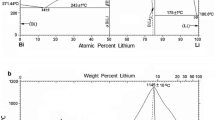Abstract
Many standard thermodynamic data in the binary system Li–Sb can be found in literature; however, they are often derived from electrochemical measurements taken at higher temperatures. The uncertainties associated with the extrapolation of these high-temperature data to room temperature are, however, inherently large. Therefore, a comprehensive investigation of the thermodynamic properties in the Li–Sb system was conducted in this work to generate more reliable data. Four different experimental techniques were used for the investigations. The heat capacities for both binary compounds, Li2Sb and Li3Sb, were measured for the very first time. In addition, the enthalpies of formation for both compounds were determined by drop solution and direct reaction calorimetry. Furthermore, Knudsen effusion mass spectrometry was performed to measure partial enthalpies and activities of Sb.






Similar content being viewed by others
References
Kubaschewski O, Seith W. Bildungswärmen von Nichteisenmetall-Legierungen. Z Metallkd. 1938;30:7–9.
LeBeau MP. Sur l’antimonuire de lithium et sur la preparation de quelques alliages de ce metal. C R Hebd Seances Acad Sci. 1902;134:231–3.
Kubaschewski O, Caterall JA. Thermochemical data of alloys. London: Pergamon Press; 1956.
Shchukarev SA, Vol’f E, Morozova MP. The enthalpy of formation of lithium antimonide. Zh Obshch Khim. 1954;24:1925–6.
Weppner W, Huggins RA. Thermodynamic properties of the intermetallic systems lithium–antimony and lithium–bismuth. J Electrochem Soc. 1978;125:7–14.
Nikitin AV, Demidov AI, Morachevskii AG. Study of alloy formation in the cathodic polarization of antimony in molten salts. J Appl Chem-USSR. 1980;53:1641–4.
Nikitin AV, Demidov AI, Morachevskii AG, Matveev VA, Il’ina OI. Thermodynamics of lithium-antimony system solid alloys. J Appl Chem-USSR. 1982;55:915–6.
Demidov AI, Dukhanin GP, Morachevskii AG. Alloy formation during the deposition of lithium on antimony and bismuth cathodes. Elektrokhimiya. 1983;19:1695–9.
Kane MM, Newhouse JM, Sadoway DR. Electrochemical determination of the thermodynamic properties of lithium–antimony alloys. J Electrochem Soc. 2015;162:A421–5.
Terlicka S, Dębski A, Fima P. Enthalpy of formation of Li2Sb and Li3Sb and mixing enthalpy of liquid Li–Sb alloys. J Alloys Compd. 2016;673:272–7.
Li D, Beutl A, Flandorfer H, Cupid DM. The Li–Sb phase diagram part II: calorimetry and thermodynamic assessment. J Alloys Compd. 2017;701:186–99.
Jackson ED, Mosby JM, Prieto AL. Evaluation of the electrochemical properties of crystalline copper antimonide thin film anodes for lithium ion batteries produced by single step electrodeposition. Electrochim Acta. 2016;214:253–64.
Haomiao L, Kangli W, Shijie C, Kai J. High performance liquid metal battery with environmentally friendly antimony–tin positive electrode. ACS Appl Mater Interfaces. 2016;8:12830–5.
Beutl A, Cupid D, Flandorfer H. The Li–Sb phase diagram part I: new experimental results. J Alloys Compd. 2017;695:1052–60.
Della-Gatta G, Richardson MJ, Sarge SM, Stolen S. Standards, calibration, and guidelines in microcalorimetry—part 2. Calibration standards for differential scanning calorimetry—(IUPAC technical report). Pure Appl Chem. 2006;78:1455–76.
Flandorfer H, Gehringer F, Hayer E. Individual solutions for control and data acquisition with the PC. Thermochim Acta. 2002;382:77–87.
Henriques D, Motalov V, Bencze L, Fürtauer S, Markus T. Experimental thermodynamics of the Li–Sn system by Knudsen effusion mass spectrometry. J Alloys Compd. 2014;585:299–306.
Hilpert K, Ruthardt K. Determination of the dissociation energy of the diatomic chromium molecule. Ber Bunsenges Phys Chem. 1987;91:724–31.
Brauer G, Zintl E. Konstitution von Phosphiden, Arseniden, Antimoniden und Wismutiden des Lithiums, Natriums und Kaliums. Z Phys Chem Abt B Chem Elem Aufbau Mater. 1937;37:323–52.
Müller W. Darstellung und Struktur der Phase Li2Sb. Z Naturforsch Pt B. 1977;32:357–9.
Barrett CS, Cucka P, Haefner K. The crystal structure of antimony at 4.2, 78 and 298°K. Acta Crystallogr. 1963;16:451–3.
Dinsdale AT. SGTE Data for Pure Elements. Calphad. 1991;15:317–425.
Emsley J. The elements. New York: Oxford University Press; 1989.
Gérardin R, Aubry J. Préparation et identification d’un nouveau compose. binaire Li2Sb. C R Acad Sci Paris Sér C. 1974;278:1097–8.
Thomas D, Abdel-Hafiez M, Gruber T, Huttl R, Seidel J, Wolter AUB, Buchner B, Kortus J, Mertens F. The heat capacity and entropy of lithium silicides over the temperature range from (2 to 873) K. J Chem Thermodyn. 2013;64:205–25.
Thomas D, Zeilinger M, Gruner D, Huttl R, Seidel J, Wolter AUB, Fassler TF, Mertens F. The heat capacity and entropy of the lithium silicides Li17Si4 and Li16.42Si4 in the temperature range from (2 to 873) K. J Chem Thermodyn. 2015;85:178–90.
Schäfer H, Axel H, Menges E, Weiss A. Crystal structure of the phase Li7Si2. Z Naturforsch B. 1965;20b:1010.
Schneider A, Hilmer O. Wärmeinhalte und Schmelzentroien von NaTl-Phasen. Z Anorg Allg Chem. 1956;286:97–117.
Binnewies M, Milke E. Thermochemical data of elements and compounds. Weinheim: Wiley; 2002.
Haynes WM, Lide DR. CRC handbook of chemistry and physics: a ready-reference book of chemical and physical data. 95th ed. Boca Raton: CRC Press/Taylor and Francis; 2011.
Raj D, Bencze L, Kath D, Oates WA, Herrmann J, Singheiser L, Hilpert K. Thermodynamic activity measurements in the B2 phases of the Fe–Al and Ni–Al systems. Intermetallics. 2003;11:1119–24.
Gurvich LV, Iorish VS, Chekhovskoi DV, Ivanisov AD, Proskurnev AY, Yungman VS, Medvedev VA, Veits IV, Bergman GA. IVTHANTHERMO—database on thermodynamic properties of individual substances. Moscow: Institute of High Temperatures; 1993.
Acknowledgements
This work was supported by the German Research Foundation “Deutsche Forschungsgemeinschaft (DFG)” within the DFG priority program SPP1473 “WeNDeLIB.” V. Motalov thanks the Ministry of Education and Science of the Russian Federation (Project No. 4.3232.2017/PP).
Author information
Authors and Affiliations
Corresponding author
Rights and permissions
About this article
Cite this article
Beutl, A., Henriques, D., Motalov, V. et al. A thermodynamic investigation of the Li–Sb system. J Therm Anal Calorim 131, 2673–2686 (2018). https://doi.org/10.1007/s10973-017-6795-1
Received:
Accepted:
Published:
Issue Date:
DOI: https://doi.org/10.1007/s10973-017-6795-1




